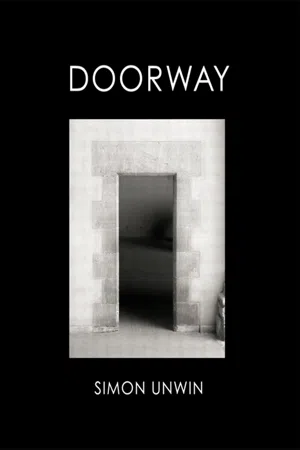eBook - ePub
Doorway
About this book
Though we may take them for granted, doorways impinge on our lives in many ways. Their powers are even richer and more varied than those of the wall. They can change the ways we behave, and alter how we see our surroundings. They challenge us and protect our territories. They punctuate our experiences as we move from place to place. They set the ge
Frequently asked questions
Yes, you can cancel anytime from the Subscription tab in your account settings on the Perlego website. Your subscription will stay active until the end of your current billing period. Learn how to cancel your subscription.
At the moment all of our mobile-responsive ePub books are available to download via the app. Most of our PDFs are also available to download and we're working on making the final remaining ones downloadable now. Learn more here.
Perlego offers two plans: Essential and Complete
- Essential is ideal for learners and professionals who enjoy exploring a wide range of subjects. Access the Essential Library with 800,000+ trusted titles and best-sellers across business, personal growth, and the humanities. Includes unlimited reading time and Standard Read Aloud voice.
- Complete: Perfect for advanced learners and researchers needing full, unrestricted access. Unlock 1.4M+ books across hundreds of subjects, including academic and specialized titles. The Complete Plan also includes advanced features like Premium Read Aloud and Research Assistant.
We are an online textbook subscription service, where you can get access to an entire online library for less than the price of a single book per month. With over 1 million books across 1000+ topics, we’ve got you covered! Learn more here.
Look out for the read-aloud symbol on your next book to see if you can listen to it. The read-aloud tool reads text aloud for you, highlighting the text as it is being read. You can pause it, speed it up and slow it down. Learn more here.
Yes! You can use the Perlego app on both iOS or Android devices to read anytime, anywhere — even offline. Perfect for commutes or when you’re on the go.
Please note we cannot support devices running on iOS 13 and Android 7 or earlier. Learn more about using the app.
Please note we cannot support devices running on iOS 13 and Android 7 or earlier. Learn more about using the app.
Yes, you can access Doorway by Simon Unwin in PDF and/or ePUB format, as well as other popular books in Architecture & Architecture General. We have over one million books available in our catalogue for you to explore.
Information
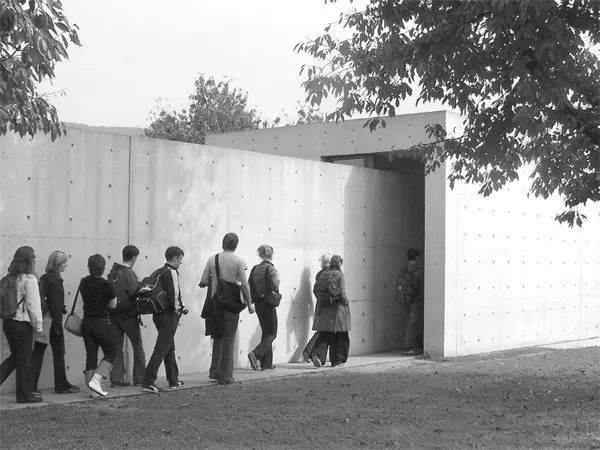
Experiencing Doorways
Threshold
‘A threshold is a sacred thing.’ Porphyrus (The Nymph’s Cave, AD3rdC).
Recall that frisson as you step through an opening. It is as if, in a small sense, you are pushing yourself through a membrane. You half wonder whether you will encounter some strange subtle resistance, whether your passage across the threshold will change you in some way, or expose you to some unforeseen threat.
As I have already suggested, crossing a threshold or entering a place is something we do so often that most of the time we do it without thinking, even though part of our minds is always conscious of where we are and where we are going. We are aware that entering takes us from one situation into another, and we are attuned to all sorts of things that are associated with that frequent action – such as whether we have gone into the right place, whether it is safe, whether it is empty or occupied by somebody else, whether we would rather not be there and want to go out again … But generally we take threshold crossing for granted; (except perhaps when we are thwarted: by a locked door; a ‘NO ENTRY’ sign; someone pushing a swing-door at the same moment from the other side; or some officious bouncer, doorman or head waiter who will not let us into that club, hotel or restaurant).
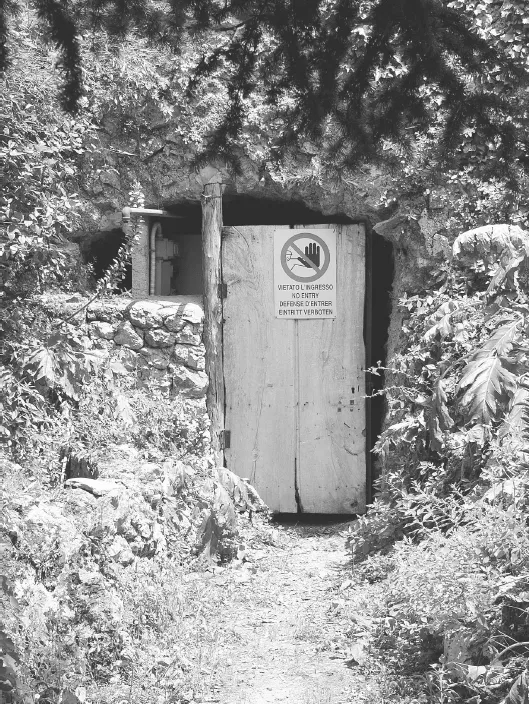
Passing through
Imagine the sensation of approaching and passing through the doorway in this photograph. Its dimensions are large enough to accommodate you comfortably; you can walk through easily, without stooping, brushing against the walls or turning sideways. And yet you sense that frisson as you go in. You know it is safe to enter but you are not quite sure what you will find inside. It is a sensation we all experience so often that, until reminded of it, we hardly acknowledge it.
Subliminally, you sense the implacability of the wall as you pass through. Its mass is made visible by the separate smooth and chamfered quoins and voussoirs around the doorway. You can empathise with the arch bearing all that weight. You might touch the jamb as you go through, feeling the hardness and texture of the stone with your fingers.
There is a step. You have to make just a little effort to step up. The sill is of a different, white, stone. The floor surface inside the threshold is different from that outside. You cannot see in the black-and-white photograph, but the tiles inside are a rich red, in contrast to the grey stone and sandy-coloured cobbles outside.
As you go through the doorway, the atmosphere changes. The warm sunshine penetrates a little way inside but as you pass through the doorway you pass from light to dark; your eyes have to adjust to the new light level. The air and its movement change. Inside, any slight breeze is stilled. It is cooler. You sense the different quality of that air as you breath it and it touches your skin. There is a slight change in ambient sound: outside noises are muffled; your footsteps reflect off the hard surfaces of the more enclosed space. You feel separated from the world, from other people, from the sky. Inside there is more privacy; a greater sense of security.
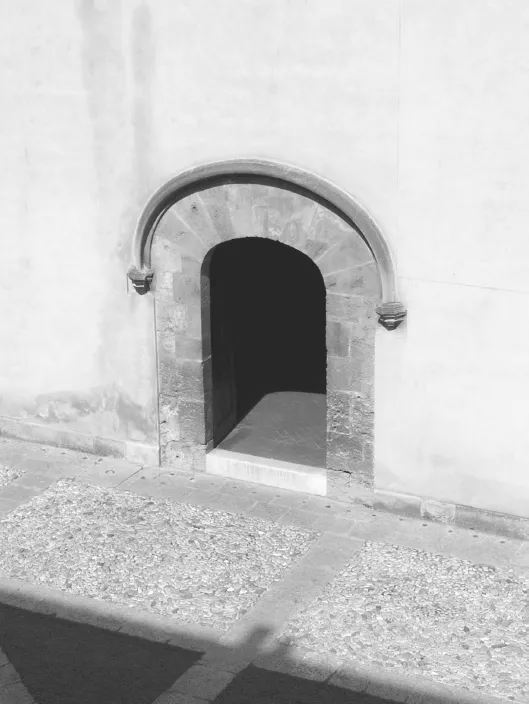
This doorway, like that on the title page of the Introduction, is in the Palazzo Abatellis in Palermo.
The space you enter contains art objects. Almost immediately your mind turns to them. But after a little while you might turn around and see that the opening, which from outside was dark, is now bright with light, with different things framed in it – grass with a loggia beyond. The same doorway is now an entrance in the opposite direction, an entrance into the courtyard. You have experienced two very different environments, linked by an opening through which you can pass, to and fro, in an instant.
Seams in Experience
The film editor Walter Murch [Godfather_III (1990), Apocalypse Now (1979), English Patient (1996), amongst many others] suggested that a good cut between shots should occur just when the watcher would blink naturally, and thus go unnoticed; the eyes would close for an instant and reopen in a new scene. Unless we make a conscious effort not to, or unexpected circumstances intervene, we tend to treat doorways like this.
Approaching a simple doorway we prepare to enter the inside or outside to which it gives access. Then, as we go through, we mentally blink, ready for the new scene – the new and different set. It is as if the transition itself, that passing instant, is empty, without meaning and therefore discounted, disregarded, passed though without a thought. Before entering, your mind projects itself forward in anticipation of the new scene shortly to be encountered. Upon passing through, the new scene and its contents have to be appraised, assimilated, brought into focus and put into some sort of sense. We may not even remember stepping through the doorway, the mind being pre-primed to give its full attention to the new scene.

A threshold offers the opportunity of a seam in one’s experience of the world.
Doorways are seams in experience. The discovery of the phenomenological transportation they offered (provided) must have seemed, to those of us long ago who experienced them when they were less ubiquitous than they are in the modern world, like a spiritual experience, an epiphany.
In The Sacred and the Profane (1957) Mircea Eliade wrote:
‘To exemplify the nonhomogeneity of space as experienced by nonreligious man, we may turn to any religion. We will choose an example that is accessible to everyone – a church in a modern city. For a believer, the church shares in a different space from the street in which it stands. The door that opens on the interior of the church actually signifies a solution of continuity.’ (Sic; presumably translated from ‘solution de continuite” – i.e. a discontinuity or fault-line.) ‘The threshold that separates the two spaces also indicates the distance between two modes of being, the profane and the religious. The threshold is the limit, the boundary, the frontier that distinguishes and opposes two worlds – and at the same time the paradoxical place where those worlds communicate, where passage from the profane to the sacred world becomes possible. A similar ritual function falls to the threshold of the human habitation, and it is for this reason that the threshold is an object of great importance. Numerous rites accompany passing the domestic threshold – a bow, a prostration, a pious touch of the hand, and so on. The threshold has its guardians–gods and spirits who forbid entrance both to human enemies and to demons and the powers of pestilence. It is on the threshold that sacrifices to the guardian divinities are offered. Here too certain palaeo-oriental cultures (Babylon, Egypt, Israel) situated the judgement place. The threshold, the door show the solution of continuity…’ (‘identify the fault-line…’) ‘in space immediately and concretely; hence their great religious importance, for they are symbols and at the same time vehicles of passage from the one space to the other.’
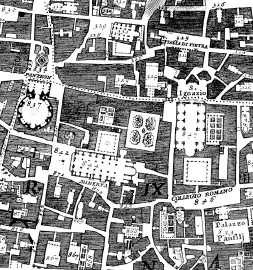
The 1748 “Nolli’Plan of Rome, shows the internal layouts of the churches as part of the public realm. But their doorways differentiate their religious space from the profane space of the city streets and squares outside.

Threshold
In farming practices of the past, thresholds were timber boards placed across opposing doorways of a barn during threshing.
Threshing involved beating harvested wheat to loosen its protective husk and then tossing the mixture of grain and husks in the natural breeze between the two opposing doorways so that the lighter husks would blow away leaving the grain behind. The thresholds helped keep the valuable grain inside the barn so that it could be collected for grinding into flour. This is the literal meaning of the word. But in this book we have to think of ‘threshold’ more abstractly. The power of that timber board across the doorway of a barn was not only that it trapped the grain but also that it defined the precise interface between inside the barn and outside. As such it marked a significant junction between places, situations.
But the junction exists whether the board is there or not; the board only draws attention to the interface and provides it with a (slightly tangential) name. When we talk about ‘crossing a threshold’ we mean moving across a boundary from one situation into another. The threshold is the two-dimensional, invisible, insubstantial but sometimes unnerving screen through which we pass.
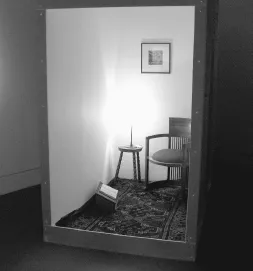
A threshold separates a place from everywhere else.
(From Experimenting with the Co-experience Environment, by Marlene Ivey, Centrespace, Visual Research Centre, Dundee Contemporary Arts, December 2005.)
Thresholds are points of introduction and control, where separated places meet. They are also points of anticipation and trepidation. They establish the discipline and art of space. They set the starting lines as well as the goals and finishing lines for the journeys we make and the games we play.
Thresholds are fascinating because they punctuate every aspect of our existence; they mark our beginnings and our ends, and many steps and stages in-between. They are instruments of surprise and revelation, mystery and concealment…. They can be used as instruments of communication and dramatic emphasis. Metaphorically and physically, thresholds mark the beginnings and ends of everything we do and experience. From time immemorial people have believed that thresholds in space and life possessed some magical association. Because of this, thresholds have been, and are still, seen as places for ritual and ceremony, for encounter and affirmation.
‘Odysseus’s heart was filled with misgivings as he hesitated before setting foot on the bronze threshold.’
Threshold Hesitation
When I am in my office I sit with the door open (right; a sketch plan is on p. 58). Its openness tells people I am in and hopefully makes it easier for them to come in to talk. I can see visitors as they approach and they can see me. They come through a farther door having peeped through the glass to see if I am in. Usually I acknowledge visitors ...
Table of contents
- Cover
- Half Title
- Title Page
- Copyright
- Dedication
- Contents
- Introduction
- The Powers of Doorways
- The Geometry of Doorways
- Experiencing Doorways
- Organising Space
- Architecture Without Doorways
- Acknowledgements
- Bibliography
- Index
